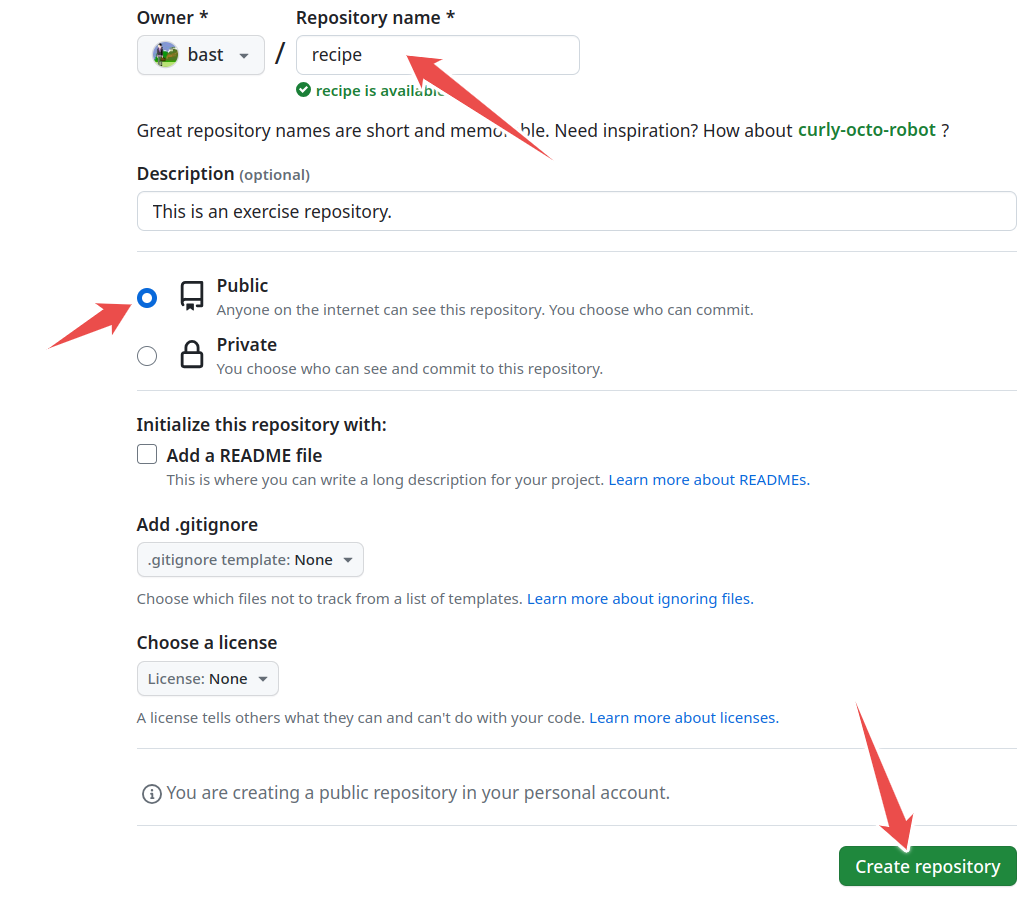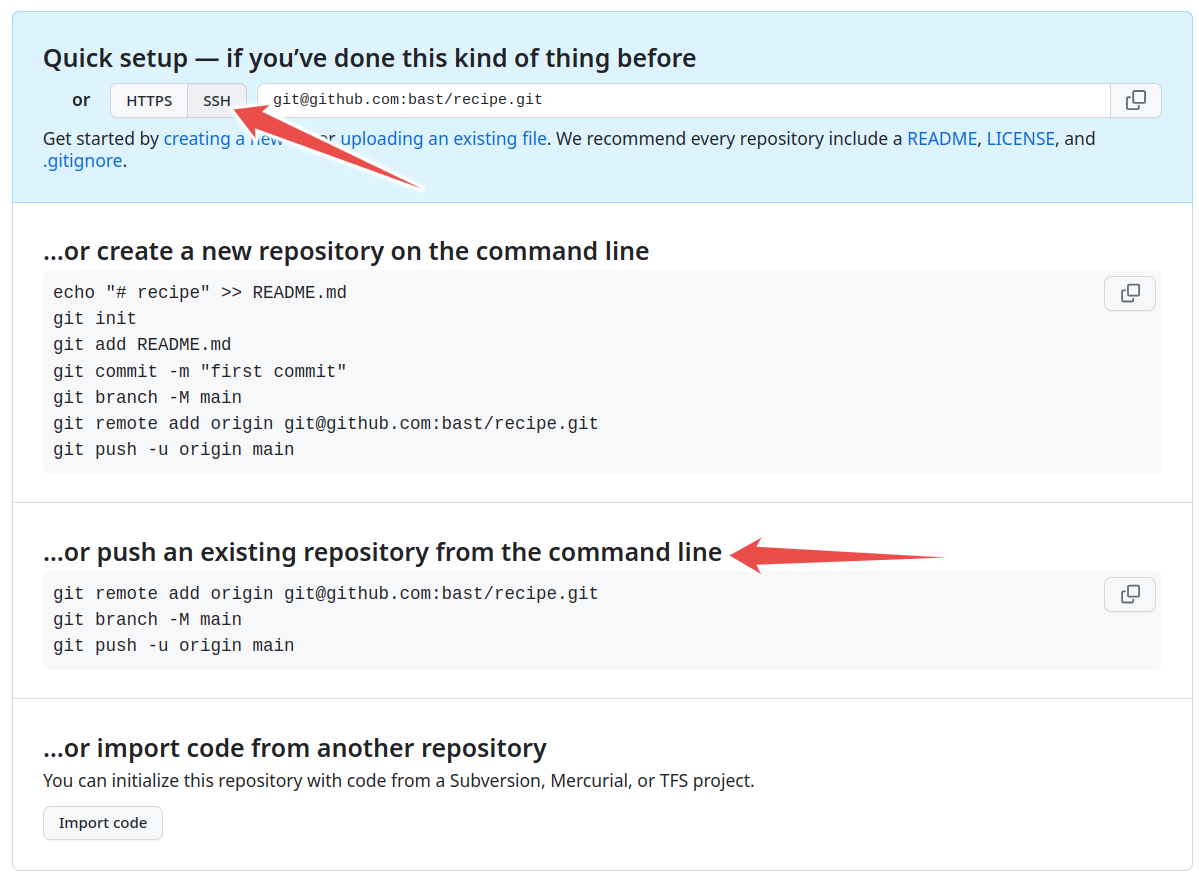Sharing repositories online
Objectives
We get a feeling for remote repositories (more later).
We are able to publish a repository on the web.
We are able to fetch and track a repository from the web.
Instructor note
15 min demonstration/type-along
25 min exercise
From our laptops to the web
We have seen that creating Git repositories and moving them around is relatively simple and that is great.
So far, if you only worked in the command line, everything was local and all
snapshots, branches, and tags are saved under .git.
If we remove .git, we remove all Git history of a project.
Discussion
What if the hard disk fails?
What if somebody steals my laptop?
How can we collaborate with others across the web?
Remotes
We will learn how to work with remote repositories in detail in the collaborative distributed version control lesson.
In this section we only want to get a taste to prepare us for other lessons where we will employ GitHub. Our goal is to publish our exercise guacamole recipe which we prepared in the previous episodes on the web. Don’t worry, you will be able to remove it afterwards.
If you don’t have the recipe repository from previous episodes
Maybe you joined the workshop later or got stuck somewhere? No problem!
If you don’t have the recipe repository from previous episodes, you can clone our version of the repository using (please skip this if you have the recipe repository on your computer already):
$ git clone https://github.com/coderefinery/recipe-before-merge.git recipe
$ cd recipe
$ git remote remove origin
Now you have a repository called recipe on your computer with a couple of
commits. Further down we will also clarify what git clone does.
To store your git data on another server, you use remotes. A remote is a repository on its own, with its own branches We can push changes to the remote and pull from the remote.
You might use remotes to:
Back up your own work.
To collaborate with other people.
There are different types of remotes:
If you have a server you can ssh to, you can use that as a remote.
GitHub is a popular, closed-source commercial site.
GitLab is a popular, open-core commercial site. Many universities have their own private GitLab servers set up.
Bitbucket is yet another popular commercial site.
Another option is NotABug.
We also operate a Nordic research software repository platform. This is GitLab, free for researchers and allows private, cross-university sharing.
Authenticating to GitHub: SSH or HTTPS?
How does Github know who you are? This is hard and there are two options.
SSH is the classic method, using Secure Shell remote connection keys.
HTTPS works with the Git Credential Manager, which is an extra add-on that works easily in Windows and Mac.
Read how to install them from the installation instructions.
Test which one you should use:
Try this command:
$ ssh -T git@github.com
If it returns Hi USERNAME! You've successfully authenticated, ...,
then SSH is configured and the following steps will work with the SSH
cloning.
See our installation instructions to set up SSH access.
From now on, if you know that SSH works, you should always select
SSH as the clone URL from GitHub, or translate the URL to start with
the right thing yourself: git@github.com: (with the trailing
:).
Try this command:
$ git config --get credential.helper
If this shows something, then the credential manager is probably configured and HTTPS cloning will work (but you can’t verify it until you try using it).
From now on, if you know that HTTPS works, you should always select
HTTPS as the clone URL from Github, or translate the URL to start with
the right thing yourself: https://github.com/
If you do not have these configured, please watch as we do this episode and you can check the installation instructions before the next collaborative Git lesson, where we will need one of these set up.
Publishing an existing repository from laptop to GitHub
If you started in the browser and have nothing on your laptop yet
It is possible, that you already have a repository on GitHub if you followed the examples and exercises in previous episodes in the browser. In this case, please watch others publish their repository and try to clone your repository to the laptop using instructions at the bottom of this page.
First log into GitHub, then follow the screenshots and descriptions below.

Click on the “plus” symbol on top right, then on “New repository”.
Another way to create a new repository is to visit https://github.com/new directly.

Choose a repository name, add a short description, but please do not check “Add a README file”**. For “Add .gitignore” and “Choose a license” also leave as “None”. Finally “Create repository”.
Once you click the green “Create repository”, you will see a page similar to:

What this means is that we have now an empty project with either an HTTPS or an SSH address: click on the HTTPS and SSH buttons to see what happens.
We now want to follow the “… or push an existing repository from the command line:
Now go to your guacamole repository on your computer.
Check that you are in the right place with
git status.Copy paste the three lines to the terminal and execute those, in my case (you need to replace the “USER” part and possibly also the repository name):
See above for if SSH is the right option for you.
$ git remote add origin git@github.com:USER/recipe.git
See above for if HTTPS is the right option for you.
$ git remote add origin https://github.com/USER/recipe.git
Then:
$ git branch -M main
$ git push -u origin main
The meaning of the above lines:
Add a remote reference with the name “origin”
Rename current branch to “main”
Push branch “main” to “origin”
You should now see:
Enumerating objects: 3, done.
Counting objects: 100% (3/3), done.
Writing objects: 100% (3/3), 221 bytes | 221.00 KiB/s, done.
Total 3 (delta 0), reused 0 (delta 0), pack-reused 0
To github.com:USER/recipe.git
* [new branch] main -> main
Branch 'main' set up to track remote branch 'main' from 'origin'.
Reload your GitHub project website and - taa-daa - your commits should now be
online! What just happened? Think of publishing a repository as uploading
the .git part online.
Troubleshooting
error: remote origin already exists.
Explanation: You probably ran a
git remote add origin ...command, then changed your mind about HTTPS or SSH and then tried to run the othergit remote add origin ...command but “origin” then already exists.Recovery:
First remove “origin” with
git remote remove originThen run the correct
git remote add origin ...command
remote contains work that you do not have
Explanation: You probably clicked on “Add a README file” and now the repository on GitHub is not empty but contains one commit and locally you have a different history. Git now prevents you from accidentally overwriting the history on GitHub.
Recovery:
Use
git push --forceinstead ofgit push, which will force Git to overwrite the history on GitHubNote that this is a powerful but also possibly dangerous option but here it helps us. If it’s a brand new repo, it probably is fine to do this. For real repositories, don’t do this unless you are very sure what is happening.
Cloning a repository from GitHub to laptop
Now other people can clone this repository and contribute changes. In the collaborative distributed version control lesson we will learn how this works.
At this point only a brief demo - if you copy the SSH or HTTPS address, you can clone repositories like this
(again adapt the USER in the “USER/repository.git” part):
$ git clone git@github.com:USER/recipe.git
From now on, if you are using SSH, you should pay attention and make
sure your clone URLs start with git@github.com: now and in future
lessons.
$ git clone https://github.com/USER/recipe.git
From now on, if you are using HTTPS, you should pay attention and make
sure your clone URLs start with https://github.com/ now and in future
lessons.
This creates a directory called “recipe” unless it already exists. You can also specify the target directory on your computer:
$ git clone git@github.com:USER/recipe.git myrecipe
$ git clone https://github.com/user/recipe.git myrecipe
What just happened? Think of cloning as downloading the .git part to your
computer. After downloading the .git part, the default branch (the branch pointed to by HEAD) is
automatically checked out.
Keypoints
A repository can have one or multiple remotes (we will revisit these later).
Local branches often track remote branches.
A remote serves as a full backup of your work.
We’ll properly learn how to use these in the collaborative distributed version control.